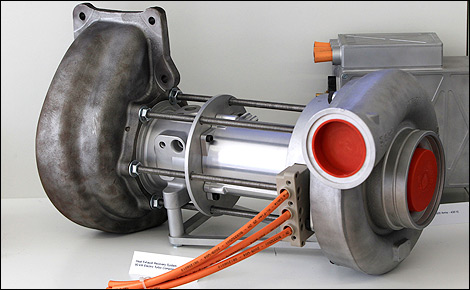Oct
30th
Stay connected Subscribe to our RSS feed
The Formula 1 engine regulation will change dramatically from 2014. Gone will be the normally aspirated, 2.4-litre V8s in favor of turbocharged, 1.6-litre V6 motors.
With this decision, the FIA hopes to close the gap that exists between the technology of the modern road going cars and the F1 cars.
For a number of years, there have been hybrid street cars available on the market. In a very good technical features written by Wayne Ward and published in Race Engine Technology magazine, the authord explains why road car technology must now find a way in race cars.
Ward explained that basic principle of a ‘normal' hybrid system, such as that in a Honda or Toyota hybrid, is that the kinetic energy which would normally be converted to heat during braking, is stored and then re-used at an appropriate time.
This is called regenerative braking, and is a laudable aim with real environmental benefits. Efficiency is increased, and less fuel should be used.
He points out that the irony is that hybrid systems on roadcars would give the greatest improvement on those that are driven aggressively.
The trucking business relies on what is called turbo-compounding -- a system where excess energy is extracted from an exhaust gas turbine and transferred back to the driveline, increasing torque.
Ward indicates that F1 will embrace a new concept in 2014, when the new engine rules take effect. The F1 rules are published in draft form on the FIA website, and define the energy recovery system (ERS) as “a system that is designed to recover energy from the car, store that energy and make it available to propel the car”, and as part of this it specifies that a “Heat Motor Generator Unit is the electrical machine linked to the exhaust turbine of a pressure charging system as part of the ERS”.
The Race Engine Technology article states that the system will be able to store recovered energy rather than having to deploy or waste any energy available to it. The ERS will combine recovery of heat from the exhaust flow and from braking. Note that the heat recovery is linked to the use of a turbocharger.
Unlike regenerative braking hybrids, this is not a piece of equipment that can be adapted to an existing, normally aspirated engine for an instant performance increase.
Ward concludes by writing “For once, motorsport will be a worthwhile development arena for relevant technologies for passenger and haulage vehicles. The FIA ought to be warmly applauded for bringing in such a brave set of rules. Unfortunately, at this early stage, involvement appears to be limited to wealthy automotive manufacturers. The costs of developing a new energy recovery system alongside a new F1 engine to compete against the likes of Renault, Mercedes and Ferrari are immense”.
With this decision, the FIA hopes to close the gap that exists between the technology of the modern road going cars and the F1 cars.
For a number of years, there have been hybrid street cars available on the market. In a very good technical features written by Wayne Ward and published in Race Engine Technology magazine, the authord explains why road car technology must now find a way in race cars.
 |
| Heat Motor Generator Unit (Photo: Magneti Marelli) |
Ward explained that basic principle of a ‘normal' hybrid system, such as that in a Honda or Toyota hybrid, is that the kinetic energy which would normally be converted to heat during braking, is stored and then re-used at an appropriate time.
This is called regenerative braking, and is a laudable aim with real environmental benefits. Efficiency is increased, and less fuel should be used.
He points out that the irony is that hybrid systems on roadcars would give the greatest improvement on those that are driven aggressively.
The trucking business relies on what is called turbo-compounding -- a system where excess energy is extracted from an exhaust gas turbine and transferred back to the driveline, increasing torque.
Ward indicates that F1 will embrace a new concept in 2014, when the new engine rules take effect. The F1 rules are published in draft form on the FIA website, and define the energy recovery system (ERS) as “a system that is designed to recover energy from the car, store that energy and make it available to propel the car”, and as part of this it specifies that a “Heat Motor Generator Unit is the electrical machine linked to the exhaust turbine of a pressure charging system as part of the ERS”.
The Race Engine Technology article states that the system will be able to store recovered energy rather than having to deploy or waste any energy available to it. The ERS will combine recovery of heat from the exhaust flow and from braking. Note that the heat recovery is linked to the use of a turbocharger.
Unlike regenerative braking hybrids, this is not a piece of equipment that can be adapted to an existing, normally aspirated engine for an instant performance increase.
Ward concludes by writing “For once, motorsport will be a worthwhile development arena for relevant technologies for passenger and haulage vehicles. The FIA ought to be warmly applauded for bringing in such a brave set of rules. Unfortunately, at this early stage, involvement appears to be limited to wealthy automotive manufacturers. The costs of developing a new energy recovery system alongside a new F1 engine to compete against the likes of Renault, Mercedes and Ferrari are immense”.
 The latest auto news, reviews, prices, product and vehicle releases.
The latest auto news, reviews, prices, product and vehicle releases.